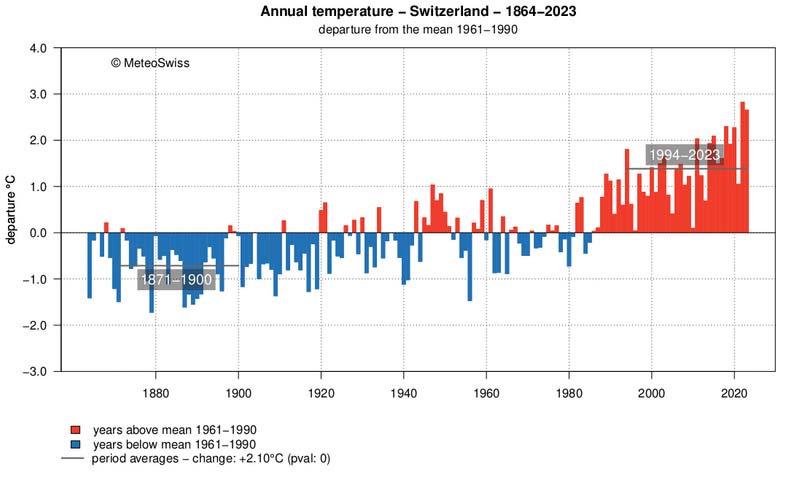Why older women are hit hardest by deadly heatwaves

Brutal heatwaves have been gripping the United States, India and other parts of the world, and older people – especially women – are most vulnerable to their effects. The issue was at the heart of the recent landmark court decision over Switzerland’s responsibility for handling climate change. What’s behind it?
2023 was the hottest year on record, and perhaps even the warmest summer in 2,000 years, as new researchExternal link suggests. Switzerland is no stranger to heatwaves, with blistering summers in 2003, 2015, 2018 and 2019, and record heatwaves in 2022 and 2023.

As human-caused climate change drives temperatures higher, dangerous heatwaves are becoming more frequent and severe, the Intergovernmental Panel on Climate Change (IPCC) has reportedExternal link. Older adults, especially over 75, women and people with chronic diseases are among the most vulnerableExternal link, especially when temperatures soar above 30°C.
Elderly women and heatwaves were at the centre of the landmark European Court of Human Rights (ECHR) climate verdict against Switzerland in April. The Strasbourg judges ruled that Bern had violated the human rights of a group of older Swiss women, the KlimaSeniorinnen, by failing to tackle climate change. In documents submitted to the court, elderly female plaintiffs complainedExternal link of health problems that are exacerbated during heatwaves and the impact on their lives.
In its decision, the court accepted that older women are more likely to die from heatwaves and elderly Swiss women are disproportionately affected by Switzerland’s weak climate policy. But what are the exact causes of the higher heat-related mortality risk among elderly women?
Women sweat less, are more active
In Switzerland, some 500 heat-related deaths were recorded in 2022 – more than the figure for road traffic fatalitiesExternal link. All of them were over 75 years old and 60% of heat-related deaths were female.
The KlimaSeniorinnen group cited researchExternal link that highlights the greater health risks facing elderly women. A 2022 study by the Swiss Tropical and Public Health Institute, for example, showed that Swiss women over 75 faced the highest risk of heat-related mortality: a 27% increased risk (31% for women over 85) in the event of a temperature rise from 22C to 33C. This compares to a 21% increased risk for men aged 75-84, and 16% for men over 85.
Research suggests various factors may explain the causes of women’s excess mortality during hot weather.
In one of the most comprehensive studies on the topic, published in 2021,External link researchers from the Vrije Universiteit Amsterdam identified possible causes. These included differences in sweating – women sweat less and lose less heat –as well as additional stress placed on women’s cardiovascular system by heat and differences in height and weight that affect women’s ability to spread heat throughout the body.
Heat stress can result in various symptoms ranging from small, reddish blisters on hands to fainting. In extreme cases, if the body temperature rises above 103F (39C), it can lead to a heatstroke, which can cause the brain and other internal organs to swell, or aggravate cardiovascular and respiratory diseases, and can be fatal. Despite this, many people seem unaware how dangerous extreme heat can beExternal link.
Martina Ragettli, who researches the health effects of heatExternal link at the Swiss Tropical and Public Health Institute (Swiss TPH), believes there are several explanations for higher heat-related mortality risk in women.
“Some physiological mechanisms to regulate the body temperature are different between men and women. For example, women often have a lower capacity to sweat or a poorer acclimatisation ability,” she told SWI swissinfo.ch.
What’s more, as women age, they are more likely to live alone, without anyone to remind them to stay hydrated. They also tend to have lower incomes and may spend more time outdoors than men.
‘Open question’
Ana Vicedo-CabreraExternal link heads the climate change and health group at the University of Bern’s Institute of Social and Preventive Medicine. She believes the causes for the higher mortality risk are “still an open question”.
“Some studies show that women might be more vulnerable to heat because of physiological processes,” she told SWI swissinfo.ch. She notes that some researchersExternal link have also cited the variations in women’s body temperature during the menstrual cycle and at the time of menopause, which may influence their ability to regulate heat.
But another vulnerability factor is that older women lead a more active lifestyle than men and are therefore more exposed to high temperatures in summer, said Vicedo-Cabrera.
At the same time, the life expectancy of women is higher compared to men (85 for Swiss women, 81 for men) “so we expect that there’s going to be more women at risk,” she added.
Click on the yellow buttons below to compare heat-related mortality data for different age groups.
Whatever the reasons, the effects of heatwaves can be devastating. A comparative epidemiological analysis published in Nature MedicineExternal link last year estimates that 63% more women than men died due to heat during Europe’s 2022 heatwave. The heat-related death toll and mortality rate rose steeply with age.
Mediterranean countries — Italy, Greece, Spain and Portugal— saw the highest death rates by population size. In absolute numbers, Italy, Spain, and Germany registered the most lives lost due to the heat: 18,010, 11,324 and 8,173, respectively.
The figures for Switzerland were lower and comparable with those of the Netherlands, Belgium and Austria. Heat-related mortality rates for Swiss men and women were roughly one-third the European average.
Overall, the researchers observed greater vulnerability of women to heat in all countries, especially in the 65-79 and 80+ age groups for women, where the heat-related death rates were 6% and 27% higher, respectively. In contrast, there were higher heat-related deaths in men aged 0–64 years (+43%). The above-mentioned Mediterranean countries all recorded the highest death rates for women.
A separate studyExternal link on heat-related deaths in Switzerland in summer 2022 published last year by the University of Bern drew similar conclusions. Human-made global warming was responsible for around 60% of 623 Swiss heat deaths, it stated. Researchers found that heat-related deaths affected people over 65 years of age in nearly 90% of the cases. The number of deaths was generally higher among women than men, and older women had the highest mortality rate.
“Without human-induced climate change, more than 370 people would not have died in Switzerland in the summer of 2022 as a result of the heat,” said Ana Vicedo-Cabrera.
More

More
Landmark ruling: Switzerland’s climate policy violates human rights
Edited by Veronica De Vore/ts

In compliance with the JTI standards
More: SWI swissinfo.ch certified by the Journalism Trust Initiative











You can find an overview of ongoing debates with our journalists here . Please join us!
If you want to start a conversation about a topic raised in this article or want to report factual errors, email us at english@swissinfo.ch.